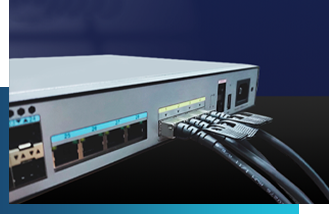
SFP28, standing for Small Form-factor Pluggable 28 Gigabit, is a hot-swappable module used for data transmission at high speeds (25 Gigabit Ethernet or 28 Gigabit Fibre Channel) over fiber optic cables. It plays a crucial role in various networking applications, especially in data centers, high-performance computing clusters, and carrier networks. Here's a detailed guide to SFP28 transceivers:
SFP28 transceivers come in various types, each serving specific needs:
SR (Short Range): Designed for short-distance connections (up to 100m) using multimode fiber, commonly used within data centers.
LR (Long Range): Covers longer distances (up to 10km) on single-mode fiber, suitable for data center interconnect (DCI) and enterprise backbones.
ER (Extended Range): Offers extended reach (up to 40km) on single-mode fiber, ideal for long-distance DCI deployments.
CWDM4: Utilizes coarse wavelength division multiplexing (CWDM) to transmit four 10Gb/s signals on different wavelengths over a single fiber, maximizing fiber utilization.
BiDi: Uses a single fiber for both transmitting and receiving data, saving fiber count and potentially reducing costs.
Data Rate: Supports 25GbE or 28GFC, significantly faster than 10GbE offered by SFP+.
Hot-swappable: Enables easy installation and replacement without network downtime.
Compact Form Factor: Fits into SFP28 ports found on most modern network equipment.
Variety of Transmission Distances: Caters to various network requirements and budgets.
Multiple Wavelength Options: Matches existing fiber infrastructure.
SFP28 transceivers, offering a significant leap in speed compared to their 10G predecessors, have become valuable players in various networking arenas. Let's delve into their key application areas:
Data Centers:
Intra-datacenter connections: SFP28 shines in connecting switches, servers, and storage within a data center.
Short-range: SR transceivers are budget-friendly for intra-rack links.
Medium-range: PSM4 transceivers cover longer distances within the facility.
High-performance computing (HPC): Interconnecting HPC clusters for parallel processing demands high bandwidth. SFP28 delivers the speed needed for efficient data movement in scientific simulations and modeling.
Cloud computing: Building high-speed connections within and between cloud data centers ensures efficient workload distribution and resource sharing. LR and CWDM4 transceivers are suitable for longer DCI links.
Carrier Networks:
Metro and access network upgrades: Modernizing these networks to handle growing mobile backhaul and broadband internet access demands. LR and ER transceivers can support longer distances in carrier networks.
5G rollouts: Facilitating the high bandwidth and low latency demands of 5G mobile networks, enabling faster and more reliable mobile experiences.
Enterprise Networks:
Network backbone upgrades: Upgrading enterprise network backbones for bandwidth-intensive applications like video conferencing, collaboration tools, and large file transfers. SFP28 transceivers provide the needed speed and capacity.
Campus network connections: Connecting buildings and campuses within an organization's network with high-speed links, improving collaboration and data sharing across offices.
Other Applications:
Research and education networks: Enabling high-speed data transfer for scientific collaborations and data analysis in research and education institutions.
Financial institutions: Supporting demanding transaction processing needs with high-speed and reliable data connectivity.
Healthcare networks: Enabling fast and reliable data access for medical imaging and patient records, improving healthcare delivery efficiency.
Manufacturing and automation: Supporting real-time data communication and control in industrial applications, ensuring smooth and efficient operations.
Selecting the optimal SFP28 transceiver depends on several factors:
Transmission Distance: Match the transceiver's reach (SR, LR, or ER) to your link length.
Fiber Type: Ensure compatibility with your network's multimode or single-mode fiber.
Data Rate: Verify the transceiver supports your desired speed (25GbE or 28GFC).
Cost: Balance functionalities with budget constraints.
Power Consumption: Consider power draw, especially in high-density environments.
Vendor Reputation and Warranty: Opt for reliable brands with suitable warranties.
Additional Considerations:
Compatibility: Ensure compatibility with your specific network equipment and switch ports.
Management Features: Some offer Digital Optical Monitoring (DOM) for performance insights.
Future Needs: Consider future bandwidth requirements and potential upgrades to faster technologies.
Beyond these core aspects, tailor your choice based on specific applications:
Data Center: Prioritize cost-effective options like SR for short links or PSM4 for longer runs within the facility.
DCI: Focus on reach with LR or ER, potentially using CWDM4 if existing infrastructure supports it.
HPC: Prioritize low latency and compatibility with your HPC equipment.
By understanding the different types, features, and applications of SFP28 transceivers, you can make an informed decision and choose the best option for your specific network needs. Remember, there's no one-size-fits-all solution, so careful evaluation is crucial for optimal performance and efficiency.
